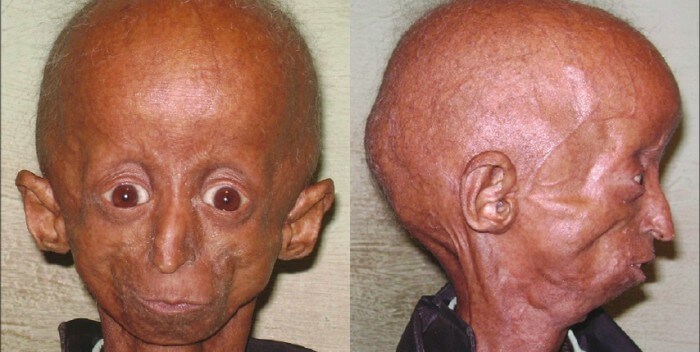First researched in 1886 by Jonathan Hutchinson and later described in 1897 by Hastings Gilford, the Hutchinson-Gilford progeria syndrome is a rare genetic condition that affects an estimated 1 in 8 million children. It is characterized by excessive premature aging, and it makes a young child look like an old man or woman. The word “progeria” is a Greek word for “pro” (before, or premature) and “geras” (old age).
Hutchinson-Gilford progeria syndrome (HGPS) generally occurs as a result of gene mutations, and cannot be inherited because patients do not usually live past their teens.
[ad name=”LinkAds”]
Characteristics of Progeria Syndrome
The major characteristic of progeria syndrome is that a young infant or child has all the features and evidences of a very old man or woman – and these can be broken down to the following:
- Limited and very stunted body growth
- Very wrinkled skin or scleroderma – a hardening and tightening of the skin all over the body
- Small and fragile bones
- Very big heads and visible scalp veins
- A narrow face and beak nose
- Prominent and bulging eyes
- Alopecia or full hair loss
- Loss of body fat and muscles
- Stiff joints, kidney failure, loss of eyesight, hip dislocation, and cardiovascular diseases
Genetic Causes of Progeria Syndrome
There is a protein called the Lamin A which is produced by the LMNA gene. The Lamin A protein influences the shapes nucleus in body cells. When genetic mutations cause abnormal production of the Lamin A protein, it causes the membrane enveloping the cell nucleus to become unstable and this development damages cell nucleus and kills them off faster than is normal. This ultimately leads to an embryo within the womb to develop progeria genes and cells, and the condition sets in the moment the child is born, until he/she passes away during the teenage years.
 Diagnosis of Progeria Syndrome
Diagnosis of Progeria Syndrome
Diagnosing progeria poses no problems at all because all the tell-tale symptoms and evidences are there for all to see. However, a LMNA mutations test can also be done to confirm the degenerative aging disease.
Similar Aging Diseases
There are a few other accelerated aging diseases that are very similar to progeria syndrome, and these are largely caused by defective DNA repairs. They have also been called segmental progerias by some medical professionals because unlike progeria syndrome, they induce accelerated aging in certain aspects of aging. Some of these degenerative aging diseases are:
- Werner syndrome
- Cockayne syndrome
- Xeroderma pigmentosum
Treatment of Progeria Syndrome
There is no known treatment for progeria, but there are treatments aimed at complications arising from the condition. For instance, depending on individual cases, patients may be treated for cardiovascular diseases using coronary artery bypass surgery, and they may also be given growth hormone treatments with high-energy diets being recommended.


